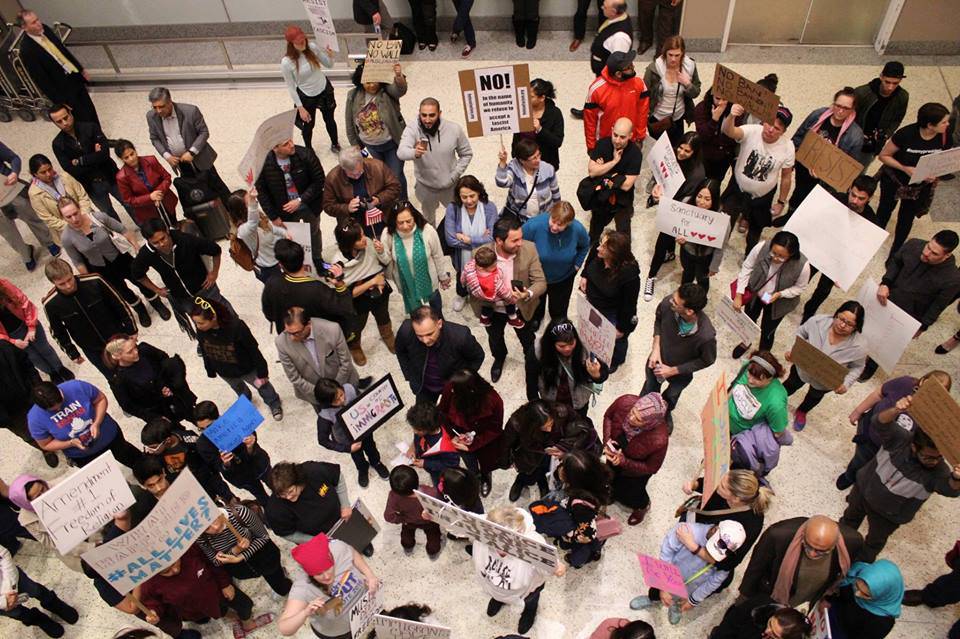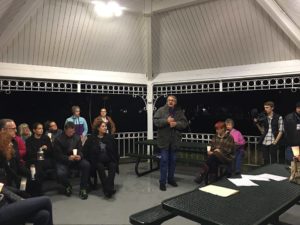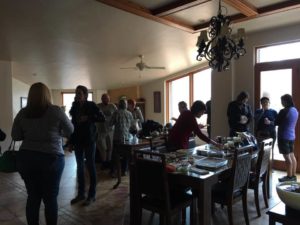
Saturday morning in a St. George cafe, I’m here to meet with Kathryn Mederos Syssoyeva — local academic, historian, and representative of a newly-formed and rapidly-growing activist organization: Action St. George. Groups like Action St. George have been emerging throughout the country to resist the current administration’s right-wing populist agenda. Above the mid-morning chatter and the whir of a coffee grinder, Syssoyeva relates how the group developed organically as local community members of various political stripes reached out on social media, looking for ways to organize against the Trump administration’s right-wing populist agenda.
“We’ve been galvanized by resistance,” she said. “And as everybody is saying, it’s true, we need to move towards positive change.”
Syssoyeva moved to southern Utah a few years ago and says she felt isolated in the first days following the election. But when she reached out to a few friends on Facebook about holding a vigil in solidarity with immigrants and minorities, she was taken aback by the response.
“When I showed up that evening, there were 40 people there, most of whom I didn’t know,” she said. “News had spread very, very fast.”

Following the vigil, Syssoyeva and others began to organize meetings for those who wanted to democratically oppose the administration’s agenda. Despite the positive initial response, however, organization was lacking, and participation waned over the first few months. Syssoyeva began to doubt.
“The whole thing was very low-key and I was very close to thinking, well, this isn’t a happening thing,” she said.
This changed with the Women’s March. The day after Trump’s inauguration, some 1,475 people lined the streets of downtown St. George in solidarity with the protests in Washington and around the globe. Afterwards, the people behind the St. George Women’s March reached out to a number of local organizers, encouraging them to use the Women’s March Facebook page to get in touch with potential supporters. The strategy proved successful.
“Within that page, things started to happen, and more real activism started to bubble,” Syssoyeva said. Action St. George was born.
Within a month, the group had nearly 300 members with two to four new members joining every day.
“I’ve never seen anything like it,” said Syssoyeva. What’s more, these members are participating actively.
“At this point, on a daily basis somebody reaches out and says how do I become more organizationally involved — these are my interests, send me to the right people,” she said.
Perhaps some of the group’s success can be attributed to its experimenting with new methods of political organizing. Ask a member of Action St. George who the “leader” is, for instance, and they’ll proudly declare, “No one.” The group is firmly committed to being independent and bottom-up — run democratically by its members and driven by local concerns, not tethered to the dictates of state or national organizations.
“I think there’s tremendous empowerment in local groups formulating their own local identity, voting on it, and knowing that this is theirs,” she said. As such, Syssoyeva says the group intends to coordinate with other organizations when interests or actions converge but always to remain an independent entity.
In part, according to Syssoyeva, this is being done to preserve some of the organizational tactics that make Action unique: tactics that members hope will help them avoid the pitfalls of more old-school American organizing. Some organizations, Syssoyeva told me, become too large and unresponsive to the needs of specific communities. To this end, Action St. George abides by the old activist adage, “Think globally, act locally.” While other organizations have emerged to tackle state-level issue — one group, for instance, is addressing the Republican gerrymandering which conspired to deprive relatively liberal Salt Lake City of congressional representation — Action St. George has its sights on what can be done at the city and county levels.
Further, the group is oriented around smaller, more intimate and conversational gatherings as opposed to big-tent assemblies.
Syssoyeva noted the potential difficulties that lie in holding meetings.
”Basically, there are two ways of having a really large meeting, and neither of them function very well,” she said. “One is someone stands and talks at everybody; the other is it’s terribly democratic, and it goes nowhere.”
To avoid these twin hazards, the group is subdivided into a number of issue-focused “action teams” — one on immigration, another on LGBT+ rights, and so on. Leadership of these groups rotates, and they often meet independently. When the organization does find occasion to come together all at once, the event is structured more along the lines of an informal social gathering — a non-alcoholic political cocktail party of sorts — thus avoiding the tyranny of the podium.
“There’s no agenda, we’re there to meet, and coalitions can emerge out of that,” she said.

At this point, I asked Syssoyeva if she saw parallels with the Occupy movement with regards to anti-hierarchical structure, for instance.
“The difference with this model is that it’s predicated on developing a very strong set of principles,” she said.
For her, this is what Occupy lacked: Anybody and everything could be “Occupy,” and she said that the internal principles were not all that clear. Action St. George, on the other hand, aims to couple a democratic structure with a greater level of internal discipline to keep the group coherent and focused. Members are not allowed, for instance, to use the group’s name to carry out actions not officially sanctioned by the group.
Utah may be a red state, especially outside of the urban north, but as Syssoyeva pointed out, the political realities in the United States are more nuanced than red vs. blue.
“When we speak about ‘red states,’ what’s actually happening on the ground is far more complicated than simply having a unified conservative base,” she cautioned. “What you often have are a lot of folks who are terribly disappointed in government, and how they understand the nature of the problem can vary.”
In the age of social media bubbles, biased reporting, and even outright fake news, it seems that the country no longer shares a single narrative of factual events. These differences in the way we understand the issues facing the country, according to Syssoyeva, make our nation seem possibly more divided than it is. She says that Action St. George has also appealed to many conservatives who feel that Trump does not represent their values.
For those so inclined,Syssoyeva says that the best way to get involved is to get in touch through the group’s Facebook page or through their website, actionstgeorge.org.
Articles related to “Red state resistance: Action St. George organizes southern Utahns for political change”
On President Donald Trump and what this election proved to me



